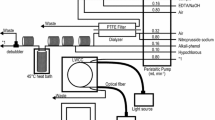Abstract
For accurately determining nutrients in seawater by continuous flow analysis (CFA), the characteristic of the calibration curve was examined in detail. Under absorbance below 0.8, the calibration curve and the bracketing methods showed more accurate results that the bias fell below 0.5%. The analytical results of dissolved silica in seawater from the nutrient maximum layer of the Pacific Ocean obtained by the proposed methods showed good agreement with those obtained by an ion exclusion chromatography postcolumn absorption spectrophotometry (IEC-postcolumn) and an ion exclusion chromatography isotope dilution ICP mass spectrometry (IEC-ID-ICP-MS). From the results, the analysis of nutrients in seawater could be accurately carried out by CFA with an expanded uncertainty of below 1% using both the calibration curve and the bracketing methods with an appropriate absorbance range.
Similar content being viewed by others
References
A. Knap, A. Michaels, A. Close, H. Ducklow, and A. Dickson, “Protocols for the Joint Global Ocean Flux Study (JGOFS) Core Measurements”, 1996, JGOFS Report No. 19, JGOFS, Woods Hole.
M. Aoyama, H. Ota, M. Kimura, T. Kitao, H. Mitsuda, A. Murata, and K. Sato, Anal. Sci., 2012, 28, 911.
B. C. Reynolds, M. Frank, and A. N. Halliday, Earth Planet Sci. Lett., 2006, 244, 431.
Certificates for NMIJ CRM 7601-a, 7602-a and 7603-a, National Metrology Institute of Japan, Tsukuba. https://www.nmij.jp/english/service/C/CRM_Catalog_(JE)_2018-2019.pdf.
M. Aoyama {etet al.}, “IOCCP-JAMSTEC 2018 Inter-laboratory Calibration Exercise of a Certified Reference Material for Nutrients in Seawater”, 2018, IOCCP Report No. 1/2018, Japan Agency for Marine-Earth Science and Technology, Yokosuka, 9.
C. L. Sabine, R. M. Key, K. M. Johnson, F. J. Millero, A. Poisson, J. L. Sarmiento, D. W. R. Wallace, and C. D. Winn, Global Biogeochem. Cycles, 1999, 13, 179.
K. Lee, S. D. Choi, G. H. Park, R. Wanninkhof, T. H. Peng, R. M. Key, C. L. Sabine, R. A. Feely, J. L. Bullister, F. J. Millero, and A. Kozyr, Global Biogeochem. Cycles, 2003, 17, 1116.
S. E. Mikaloff-Fletcher, N. Gruber, A. R. Jacobson, S. C. Doney, S. Dutkiewicz, M. Gerber, M. Follows, F. Joos, K. Lindsay, D. Menemenlis, A. Mouchet, S. A. Muller, and J. L. Sarmiento, Global Biogeochem. Cycles, 2006, 20, GB2002.
C. Cheong, N. Nonose, T. Miura, and A. Hioki, Accred. Qual. Assur., 2014, 19, 31.
ISO 13395:1996, “Water Quality—Determination of Nitrite Nitrogen and Nitrate Nitrogen and the Sum of Both by Flow Analysis (Cfa and Fia) and Spectrometric Detection”, 1996, International Organization for Standardization, Geneva.
ISO 11732:2005, “Water Quality—Determination of Ammonium Nitrogen—Method by Flow Analysis (CFA and FIA) and Spectrometric Detection”, 2005, International Organization for Standardization, Geneva.
ISO 15681-2:2018, “Water Quality—Determination of Orthophosphate and Total Phosphorus Contents by Flow Analysis (FIA and CFA)—Part 2: Method by Continuous Flow Analysis (CFA)”, 2018, International Organization for Standardization, Geneva.
I. Claramunt and L. Perez, Accred. Qual. Assur., 2014, 19, 205.
T. Kodama, T. Ichikawa, K. Hidaka, and K. Furuya, J. Oceanogr., 2015, 71, 65.
E. V. Dafner, Limnol. Oceanogr.: Methods, 2015, 13, 511.
S. Ramaswami, H. Gulyas, J. Behrendt, and R. Otterpohl, Int. J. Environ. Anal. Chem., 2017, 97, 56.
C. Cheong, Y. Yamauchi, and T. Miura, Anal. Sci., 2018, 34, 477.
K. Bakker, J. Ooijen, E. Weerlee, and E. Epping, “Comparability of Nutrients in the World's Ocean”, ed. M. Aoyama, A. G. Dickson, D. J. Hydes, A. Murata, J. R. Oh, P. Roose, and E. M. S. Woodward, 2010, Mother Tank, Tsukuba, 127.
M. Aoyama {etet al.}, “Technical Reports ofthe Meteorological Research Institute No. 60, 2008 Inter-Laboratory Comparison Study of a Reference Material for Nutrients in Seawater”, 2010, Meteorological Research Institute, Tsukuba.
A. Hioki, A. Kokubun, and M. Kubota, Analyst, 1994, 119, 1879.
N. Nonose, C. Cheong, Y. Ishizawa, T. Miura, and A. Hioki, Anal. Chim. Acta, 2014, 840, 10.
Y. Nozaki, Bull. Soc. Sea Water Sci. Jpn. (in Japanese), 1997, 51, 302.
K. Grasshoff, Deep-Sea Res., 1964, 11, 597.
R. Ramachandran and P. K. Gupta, Anal. Chim. Acta, 1985, 172, 307.
T. Kawano and H. Uchida, “WHP P10 Revisit Data Book”, 2007, Japan Agency for Marine-Earth Science and Technology, Yokosuka, 47–48.
P. Griess, Chem. Ber., 1879, 12, 426.
I. C. Huygen, Anal. Chem., 1970, 42, 407.
Z. J. Zhang, J. C. Fischer, and B. P. Ortner, Int. J. Environ. Anal. Chem., 2000, 76, 99.
C. Kato and A. Hioki, Bunseki Kagaku, 2009, 58, 723.
G. H. Ayres, Anal. Chem., 1949, 21, 652.
ISO Guide35:2017, “Reference Materials—Guidance for Characterization and Assessment of Homogeneity and Stability”, 2017, International Organization for Standardization, Geneva.
J. N. Miller, Analyst, 1991, 116, 3.
J. O. D. Beer, T. R. D. Beer, and L. Goeyens, Anal. Chim. Acta, 2007, 584, 57.
M. J. T. Milton and T. J. Quinn, Metrologia, 2001, 38, 289.
Author information
Authors and Affiliations
Corresponding author
Rights and permissions
About this article
Cite this article
Cheong, C., Sakaguchi, A., Sueki, K. et al. Evaluation of the Calibration Method for Accurate Analysis of Dissolved Silica by Continuous Flow Analysis. ANAL. SCI. 36, 247–251 (2020). https://doi.org/10.2116/analsci.19P291
Received:
Accepted:
Published:
Issue Date:
DOI: https://doi.org/10.2116/analsci.19P291




